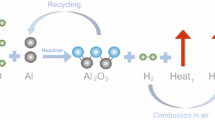Abstract
Iron nanopowders and iron and aluminum micropowders exposed to microwave radiation with a frequency of 9.4 GHz and a power density of 80 W/cm2 at a pulse repetition rate of 400 Hz have been investigated. According to the results of differential thermal analysis, the microwave radiation caused nonmonotonic changes in the thermal properties of the A1 and Fe powders. After irradiation of the iron nanopowder, the temperature of the onset of its oxidation increased from 150.01 to 158.75°C; in the case of the micropowder, the temperature nonmonotonically changed from 150.00 to 275.38°C. The specific heat of oxidation of the Fe nanopowder increased by 17.3% at maximum, while in the Fe micropowder the maximum attained increase was 13%. For the Al micropowder, the maximum increase in the specific heat of oxidation was found to be 59.7%. Microwave irradiation leads to the formation of electron avalanches, which reduce metal ions in their oxides. At the same time, at certain irradiation doses the generated electron flows oxidize the reduced metals, which is reflected in the nonmonotonic variation in the properties of a material. The increase in the specific heat of oxidation is related to the participation of energy-saturated states of the metals in the oxidation processes.
Similar content being viewed by others
References
H. Ellern, Military and Civilian Pyrotechnics (Chemical Publ., 1968).
A. A. Gromov and U. Teipel, Metal Nanopowders: Production, Characterization, and Energetic Applications (Wiley, Weinheim, 2014).
R. A. Andrievski, Phys.-Usp. 57, 945 (2014).
I. D. Morokhov, V. P. Petinov, L. I. Trusov, and V. F. Petrunin, Sov. Phys. Usp. 24, 295 (1981).
V. M. Mikoushkin and A. S. Kriukov, Tech. Phys. Lett. 42, 337 (2016).
A. P. Il’in, L. O. Root, and A. V. Mostovshchikov, Tech. Phys. 57, 1178 (2012).
J. Sun, W. Wang, and Q. Yue, Materials 9, 231 (2016).
A. N. Didenko, Microwave Energy Engineering: Theory and Practice (Nauka, Moscow, 2003).
A. V. Mostovshchikov, A. P. Il’in, P. Yu. Chumerin, Yu. G. Yushkov, V. A. Vaulin, and B. A. Alekseev, Tech. Phys. Lett. 42, 344 (2016).
V. G. Syrkin, Metal Carbonyls (Khimiya, Moscow, 1983).
W. W. Wendlandt, Thermal Methods of Analysis (Wiley, New York, 1974).
V. V. Borisovskii, A. A. Vorob’ev, E. M. Golovchanskii, and E. K. Zavadovskaya, Izv. Tomsk. Politekh. Inst. 247, 6 (1977).
A. V. Mostovshchikov, A. P. Ilyin, I. S. Egorov, and D. V. Ismailov, Key Eng. Mater. 712, 60 (2016).
F. Brecelj and M. Mozetic, Vacuum 40, 177 (1990).
N. Standish and H. Worner, J. Microwave Power Electromagn. Energy 25, 177 (1990).
J. E. Bonevich and L. D. Marks, Ultramicroscopy 35, 161 (1991).
D. J. Smith, M. R. McCartney, and L. A. Bursill, Ultramicroscopy 23, 299 (1987).
S. P. Bardakhanov, A. P. Zav’yalov, K. V. Zobov, et al., Vestn. Novosib. Gos. Univ., Ser. Fiz. 4 (1), 75 (2009).
Vacuum Microwave Electronics: Reviews (Inst. Prikl. Fiz. Ross. Akad. Nauk, Nizhny Novgorod, 2002).
V. N. Nikiforov, A. N. Ignatenko, and V. Yu. Irkhin, Bull. Russ. Acad. Sci.: Phys. 78, 1081 (2014).
L. V. Gurvich et al., Energy of Chemical Bond Cleavage. Ionization Potentials and Electron Affinity (Nauka, Moscow, 1974).
Author information
Authors and Affiliations
Corresponding author
Additional information
Original Russian Text © A.V. Mostovshchikov, A.P. Il’in, P.Yu. Chumerin, Yu.G. Yushkov, 2018, published in Zhurnal Tekhnicheskoi Fiziki, 2018, Vol. 88, No. 8, pp. 1259–1263.
Rights and permissions
About this article
Cite this article
Mostovshchikov, A.V., Il’in, A.P., Chumerin, P.Y. et al. Parameters of Iron and Aluminum Nano- and Micropowder Activity upon Oxidation in Air under Microwave Irradiation. Tech. Phys. 63, 1223–1227 (2018). https://doi.org/10.1134/S1063784218080133
Received:
Published:
Issue Date:
DOI: https://doi.org/10.1134/S1063784218080133




